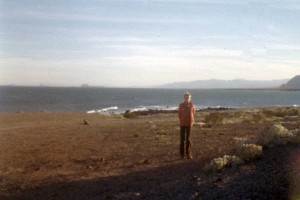
In 1978, my father and I took a road/camping excursion down the Baja Peninsula in Mexico. Apart from an earlier border excursion, this was my only trip into Mexico.
In those days, Cabo San Lucas as a tourist destination was still just a gleam in the eye of the Mexican Federal Government, and the whole peninsula was sparsely populated and untouched by much foreign influence. Because we drove down “the back road” by mistake, we went days without seeing another human being. We travelled over roads far too rough for our 4-wheel drive truck. At times, my dad made me get out of the truck and walk behind, just in case the truck tipped over a cliff.
Afterwards, he admitted the trip was a foolhardy adventure and that, had we broken down or had an accident things could have been very bad for us.
I mention it because, when we did encounter people, despite limited understanding (my father’s Spanish was better than mine) the people, as a whole, were kind, helpful and, while not living in the lap of luxury, seemed to be living full, contented lives.
Fast forward now to 2014.
Our tour, which I was increasingly afraid was going to be a miserable failure, was scheduled to pick us up at 7:00AM – the same time breakfast starts – which meant we could either have breakfast, or take the tour. There had been mention of a “continental breakfast” on the tour and, while a continental breakfast should not legally be allowed to be called “breakfast” we felt, with snacks, that it might hold us until lunch near Chichén Itzá, which was a buffet and included in the tour cost.
Tour companies came and went, calling out names and eventually thinning the ever-growing crowd of tourists waiting to be picked up for their tours of the various sights in the area, but ours steadfastly refused to arrive, and as time wore on, I began to check out more reviews, some of which involved people never being picked up (and then fighting futilely to get their money back) or people being put on the wrong bus and getting the wrong tour.
By the time I was done reading I was convinced they were never coming and when they did finally come, 30 minutes late, I wasn’t sure I wanted to go with them!
As with everything here, there seemed to be a lot of faffing about to get things done. In this case we drove to the north end of the Cancun “7” to disembark, stand in line to check in, to then be put back on a different (nearly identical) bus and head back south.
As we headed southwest, it was evident there was to be no continental breakfast.
The Yucatan peninsula is the result of the dinosaur-killing asteroid strike. What was once ocean floor was lifted up out of the water to become dry land. Geographically, it’s flat and featureless limestone, covered in jungle vegetation. It isn’t what you’d call “scenic.”
It’s hard to say exactly how long the drive is to Chichén Itzá because we certainly didn’t take a direct route. We saw other “sights” along the way to make it interesting.
The first stop was at the border between the states of Quintana Roo and Yucatan. This utterly featureless distinction between the states is marked by a gate, a toilet, a three-sided cement building with several men selling tours and police armed with AK-47s. I’m not sure if it was this later thing that was most remarkable or the strange group of men selling tours somewhere right between nowhere and nowhere.
On the trip, our tour guide gave us a lot of information about the Mayan people and the area we were traveling through, he also talked about complete bullshit, such as the obsidian energy stones the Mayan people use for massages. He talked about the Mayan calendar and their “alphabet” – which, if one didn’t think very critically about – could be forgiven for thinking was a one-to-one, letter-to-letter analog to the English alphabet.
The theme for the day was becoming evident: “You will meet many people selling things, but if you want real authentic souvenirs, buy something made by the Mayan people – a calendar, your name in Mayan letters on a silver necklace or these local energy stones.”
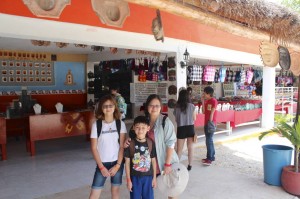
Our second stop was a… I don’t know what to call it… rest area? store? prison? The tour bus was brought into the courtyard and the gate was closed behind us. The passengers were disembarked, then the bus was taken away, leaving us for “40-45 minutes” to look around at local crafts – not surprisingly, these were exactly the sort of thing that had been described to us on the bus as the “correct” type of souvenirs to take home.
We stood around (as there were no chairs) while 45 minutes stretched to almost an hour as they tried to extract every possible bit of cash from the passengers. In the end, it felt like an unsatisfying exchange for both sides. The bus passengers felt we’d wasted a lot of our time and it seemed the local Mayan artisans felt we didn’t buy enough.
And so we went on to Chichén Itzá!
No, no we didn’t.
Next we went to lunch, which was included, except for drinks. Our drinks (3 sodas and bottle of water) were 235 pesos – thats $17!
There’s a game they like to play here, where they try to make you think the price is effectively 100-1, so the unsuspecting tourist might think they’re paying $1.30 USD for a bag of nacho Cheese Doritos when the posted price in pesos is 130. That’s totally wrong, but their pricing of items encourages that misconception.
Many places, however, will take US Dollars without having to exchange them, but most places outside the hotels exchange at rate of 10-1 because it’s “easier” and they do have some expense getting the money changed. Tourists do find this easier because a 13-1 exchange rate is harder to do on the fly in your head. If those Doritos are marked in both pesos and dollars, it will usually be like this $130/$13US. Of course, you should pay in pesos because that’s really only about $9.83US
The rate is really about 13-1, and if you exchange money at a proper money exchanger, or use your credit card, you’ll get the fair daily exchange rate.
It’s still an outrageous price, but you can be prepared by knowing what to expect and by developing a strategy in your head to convert prices. I found 13-1 to be difficult to do when discussing prices, so I worked out a simple two-step process that approximated the price closely enough that I could grasp the price quickly. Take any peso price, crop the decimal, then knock a quick 25% off that figure. That is 100 peso => $10US => $7.50US (Today’s exchange rate says it’s exactly $7.56US) Remember that rates change and they may not be the same when you’re reading this.
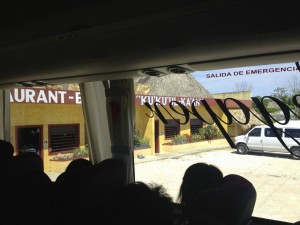
Lunch was a sad experience. It’s not that the food wasn’t good – it was, especially a local pork dish called cochinita pibil, but the problem was the hollow, soulless desperation that permeated the air. The restaurant was large – bg enough to handle perhaps 200 people, but it was completely empty, waiting for the tour busses.
When we pulled in, they sprang into action, preparing the buffet and cooking the tortillas. We were served by waiters who reminded us, directly, that tips were how they were paid and then we were entertained by some of the saddest, most bored looking dancers ever. Their sole purpose was just to dance with beer bottles on their heads for tips when the busses arrive.
Like most restrooms in Mexico, the toilets also had an attendant. Tipping is expected – a holdover from the ancient times when men’s room attendants handed out clean towels to the guests. Now, they just stand next to the air driers or paper towel dispensers and expect a tip.
Perhaps they understood that the times and technology had passed them by. The attendant made sure I knew I was to tip him by working the paper towel dispenser while I was washing my hands and then brought me the paper, weighing it down with the tip plate, just to make sure I knew.
The whole little town that the restaurant was in just looked crushingly poor. This was the face of real life in Mexico away from the resorts. It was nothing like the small fishing communities I had seen in 1978.

Finally on to Chichén Itzá.
In 2007, Chichén Itzá was voted as part of the New7Wonders of the World and it’s a deserving of it’s place on the list. Built somewhere around 750 BCE, this large, ornate city is all sorts of awesome. Alternatively majestic, advanced, unfair and brutal, the mystery of the abandonment of this and some 8,000 other Mayan cities by the 16th century is compounded by the outrageous destruction of all the written Mayan books by the Catholics. The language and culture remain largely lost to us.

The Mayan people existed in a class system that divided the rulers from the working people, who were not educated, while the royals, the priests and the astronomers were well-educated. The descendants of the workers still exist as the Mayan people today, but the other classes disappeared with their knowledge.
At least the tour guide didn’t suggest that aliens had taken them back to the stars.
He did spin some mighty tenuous connections with other things, though. Our guide had a tendency to place two or more ideas back to back, such as “This lunar cycle is 10 26 day periods long. 10*26=260.” “In Mayan culture, there are 2 cycles, the sun and the moon.” “There are two types of people, men and women.” “You know what else is 260 days long? That’s the length of a human pregnancy.”
He’d then finish that with, “Do you follow me?”
Yes, I follow you. You’re horseshitting us.
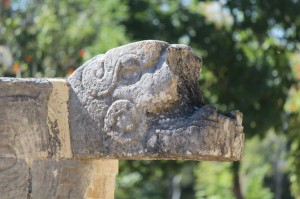 I have no doubt that the guide was knowledgeable on the subject, but by using this rhetorical technique to make things more “amazing” than reality warranted, it diminished the experience for me. Perhaps I was the only one that there that really cared about the scholarship. It did make for a great story and since you pay the tour guide in tips afterwards, he has plenty of reason to embellish to entertain the masses.
I have no doubt that the guide was knowledgeable on the subject, but by using this rhetorical technique to make things more “amazing” than reality warranted, it diminished the experience for me. Perhaps I was the only one that there that really cared about the scholarship. It did make for a great story and since you pay the tour guide in tips afterwards, he has plenty of reason to embellish to entertain the masses.
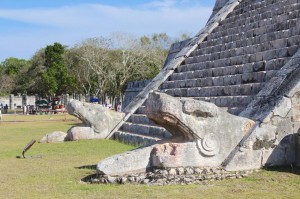
There were hundreds of people at the site, but we planned our trip to be today because it wasn’t Thursday. Thursday is the Spring Equinox and the Mayan astronomers and engineers apparently (it’s not documented, just observed) built the pyramid known as El Castillo in such a way that, on the equinoxes, the sun and shadows form the body of a snake slithering down the pyramid. We missed that, of course, by coming today instead of Thursday (or is it Friday?) when we’d get to enjoy that experience with an estimated 35,000 other people there for moment. I can pass on that.
(I say Thursday or Friday because, astronomically, the equinox is on Thursday, but apparently the shadow event happens on Friday. Could it be the Mayan engineers goofed?)
My dad’s and my trip into Mexico in 1978 was a test run for his desire to get down to see the Mayan ruins the next year. That second trip never happened because of how slow and difficult our first trip was, but after I’d moved away from home, sometime in the 1990s, my dad managed to take a driving trip to see Chichén Itzá and the other major sites such as Tolum. Back then, he got the opportunity to climb El Castillo.
In 2004, the Mexican government blocked access to the buildings because people were climbing up to the top, marking graffiti on the walls and shitting in the temple.
What the FUCK people?!
It’s really, really hard for me to have a positive attitude towards humans. I try, I really do, but things like this bugger belief.
After 2-3 hours, we left Chichén Itzá to return to Cancún. Along the way, we stopped at a cenote.
As I mentioned, the Yucatan Peninsula is all flat and monotonous limestone, covered in jungle. Limestone is easily dissolved by water and forms caves, these caves riddle the peninsula and as the roofs collapse in (think sinkhole) they formed what the locals call cenotes. These cenotes are the key to Mayan civilization, for they were filled with fresh water. Like a desert oasis, the cities formed near the cenotes.
The Mayans used them for many things, water, religion and even human sacrifice. Now, tour groups visit them and go swimming in them, which was kind of cool.
We finally got back after 8:30PM, too late for our dinner reservation at the Mexican restaurant, but with enough time to get some dinner at the buffet. The buffet is limited, but occasionally has good grilled beef or pork and they always seem to have fresh spaghetti in meat sauce. I’m liking the spaghetti in meat sauce.
Tomorrow we go to swim with the dolphins. I fully expect James to practically poo his pants in excitement but, honestly, I’m not really all that jazzed on the idea. Perhaps as a native desert-dweller I shall never really appreciate water activities.
Still no wifi. I can’t post these daily blog entries nor upload any substantial pictures from the cameras (other than my iPhone.)